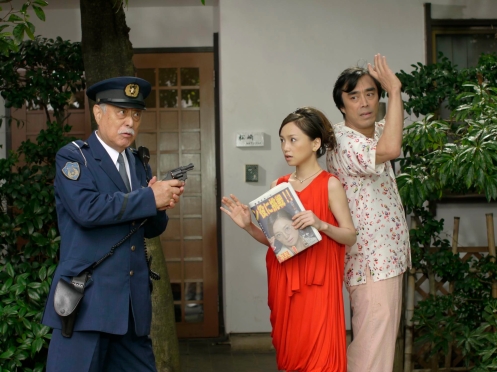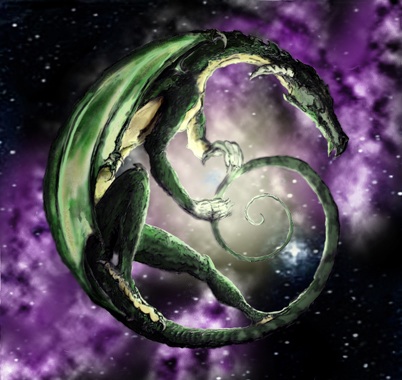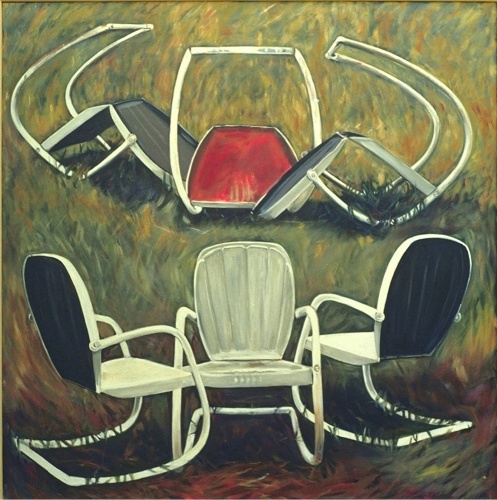 This week we return to the Artist Spotlight Series for a fascinating discussion with artist Catherine Chalmers. Chalmers holds a B.S. in Engineering from Stanford University and an M.F.A. in Painting from the Royal College of Art in London. She has exhibited her artwork around the world, including MoMA PS1, New York; Corcoran Gallery of Art, Washington DC; Kunsthalle Basel; Kunsthalle Vienna; MOCA Taipei; among others. Her work has appeared in a variety of publications, including the New York Times, Washington Post, Time Out New York, ArtNews and Artforum. She has been featured on PBS, CNN, NPR, and the BBC. Two books have been published on her work: FOOD CHAIN (Aperture 2000) and AMERICAN COCKROACH (Aperture 2004). Her video “Safari” received a Jury Award (Best Experimental Short) at SXSW Film Festival in 2008. In 2010 Chalmers received a Guggenheim Fellowship. This summer she is the Artist-in-Residence at Pilchuck Glass School. Chalmers lives and works in New York City.
This week we return to the Artist Spotlight Series for a fascinating discussion with artist Catherine Chalmers. Chalmers holds a B.S. in Engineering from Stanford University and an M.F.A. in Painting from the Royal College of Art in London. She has exhibited her artwork around the world, including MoMA PS1, New York; Corcoran Gallery of Art, Washington DC; Kunsthalle Basel; Kunsthalle Vienna; MOCA Taipei; among others. Her work has appeared in a variety of publications, including the New York Times, Washington Post, Time Out New York, ArtNews and Artforum. She has been featured on PBS, CNN, NPR, and the BBC. Two books have been published on her work: FOOD CHAIN (Aperture 2000) and AMERICAN COCKROACH (Aperture 2004). Her video “Safari” received a Jury Award (Best Experimental Short) at SXSW Film Festival in 2008. In 2010 Chalmers received a Guggenheim Fellowship. This summer she is the Artist-in-Residence at Pilchuck Glass School. Chalmers lives and works in New York City.
TSI: I have this image of you as Izumi from “The Girl Who Loved Caterpillars”: a young girl, about four or five, hands playing in the dirt in San Mateo, CA. You’re talking to the ladybugs and petting the earthworms, and when the sun goes down, they come home with you, and you keep them in pretty cages and call each one by name as you whisper ‘good night.’ Am I way off?
CC: Yes… a bit. I do, though, remember as a young girl I liked to pick up bees by their wings. I’d watch and listen to them buzz up close. It’s amazing I never got stung. I’d let them go, none the worse for their brief diversion.
TSI: Did you have many notions as a young girl or adolescent about your own relationship to animals?
CC: My father had an outside aviary and he gave me a baby parakeet to raise when I was about eight. It followed me everywhere – ate from my cereal bowl, danced to my music. I also was enormously attached to the family dog. When I got in trouble or felt misunderstood, I would seek solace from them both. My earliest notion of animals, besides being a lot of fun, was that they were an alternative source of emotional support.
TSI: You attended Stanford for undergrad and received your B.S. in engineering. Did you have different career plans when you started attending college or did you always see yourself working in the arts?
CC: I had no intention of being an artist when I entered Stanford. But, I did major in an engineering program that focused on creativity and innovation – they wanted us to be inventors in a broad classical sense – and in many ways it was a perfect start to becoming an artist. I took every studio art course offered, but I thought it was just for fun. And I was right, it still is.
TSI: What brought you to NYC?
CC: After finishing my M.F.A. in London I had to leave after my student visa expired. Certainly going back to the Bay Area would have been a lot easier, I didn’t know a soul in New York City, but I wanted to be in the center of the art world. I wanted to live in a culturally rich and diverse city and it was important to me to be surrounded by a community of artists.
TSI: Every artist has a NYC story. Is there one you can share with us?
CC: It can be unsettling to move to NYC all by yourself. Within the first week of living here, someone knocked on my door. She said she was my neighbor and that I needed to seal up the cracks between our apartments, especially under my front door. She said she was having an exterminator come and her roaches would simply run out of her place, squeeze under my front door and move in with me. You can imagine the vision I had of this horde of roaches running my way. I was horrified and wanted to go back to California right then and there.
TSI: I read somewhere that you are an artist who “explores humankind’s misconceptions about nature.” Does that feel true for you?
CC: Hopefully our conceptions as well as our misconceptions.
TSI: What first prompted the desire for that sort of exploration?
CC: On a personal level, I think I was born with an over-active sense of what E.O. Wilson calls “biophilia.” And on a conceptual level I’m interested in our relationship to animals because I live in a time in history when humans are making so many of them go extinct.
TSI: Please tell us about how you got started with the flies. I think they were first, right?
CC: It was one of the few animals I would see in my apartment on a regular basis. It occurred to me I knew nothing about them, other than the windowsill was their graveyard of choice. So I decided to start raising them and take a closer look.
TSI: In your book, Food Chain: Encounters Between Mates, Predators, and Prey, your images portray, as one might imagine, snakes, frogs, etc., devouring their lunches. Can you talk about how that idea came about?
CC: I remember watching my friend’s dog violently shake its squeaky toy. The more the toy squealed the more excited the dog became. I thought how ironic it was that humans, the ultimate predator, are so queasy about facing the deaths of the animals we kill. We generally don’t like our food to squeal and squirm on a fork. I realized how removed I was from the basic functions of the ecosystem.
TSI: It had to have been very difficult for you, at some point, I would think, knowing that you were raising animals for the sole purpose of being photographed while being eaten. While you understand that this is something that happens in nature, it had to have felt a little different, with such a deliberate staging. How did you deal with that struggle?
CC: It was hard. Before I fed a praying mantis, my favorite insect, to my frog, I’d procrastinate for hours – clean the bathroom, scrub the floor – anything to delay putting the two together. But dealing with these conflicting emotions and thoughts led me to the heart of many issues. Why would I choose one side or another? Was that appropriate or even relevant?
TSI: Where did you shoot the images? Where were the animals raised?
CC: It all took place in my loft in downtown NYC.
TSI: This was a pretty elaborate project. Did you make many mistakes along the way?
CC: No, fortunately. I would have felt terrible if something died because of poor care. The maintenance of so many creatures was complicated and terribly time consuming. At one point my dining room table was covered with hundreds of individually housed, baby praying mantises (they’re cannibalistic). Everyday I’d feed a fly to each one. It took hours. Can’t believe I did it.
TSI: Many people had strong reactions to your work in Food Chain, finding many of the images to be really disturbing. Do you find it interesting that viewers will sit and cozy up in front of a nature documentary on life in the desert, but then to see a snapshot of a snake eating a mouse against a white background is considered, somehow, cruel? It’s like, with the buttery voice of the narrator and the swell of the music missing, it all becomes just a bit too real. What’s your take on that disconnect?
CC: It seems to me that nature documentaries often emphasize the divide between humans and nature. For most people, as long as nature stays over there, we accept it being red in tooth and claw and, as every TV producer knows, viewers get a thrill watching, from the comfort of the couch, animals tearing one another apart. But, when nature unfolds in the human realm, people’s reactions are all over the map. Just because my snake lives and eats in SoHo doesn’t mean it can or should become a vegetarian.
TSI: The placement and order of the photographs were incredibly effective. What were you hoping to evoke in your audience?
CC: I hope to elicit an appreciation of that which is so different from us.
TSI: Did you hear much either way from animal rights activists?
CC: Nothing negative. One organization wanted to use one of my frog photos on the cover of their journal.
TSI: Let’s talk about roaches – across the board, probably not a real favorite, in terms of the friendly family pet. But, apart from making some folks sneeze a whole heck of a lot, they don’t really do much to us, do they? I mean, how dangerous is the average cockroach living behind a reading room wall in Brooklyn? Maybe it’s a power-in-numbers thing. We’re afraid that they’ll take off with the fridge while we’re sleeping…
CC: Cockroaches are psychologically more disturbing than physically threatening. They’re not venomous, they don’t bite or sting, and they’re not vectors of disease like flies, mice, fleas, and ticks. I think their greatest affront to our sensibilities is that they’re uninvited and we can’t control them.
TSI: We seem to make our determinations about an animal’s value in relation to us based on visual considerations. Is it soft? Is it fuzzy? Is it purple with yellow spots? We like color. We like fur. Roaches seem to get the short end of the stick for being…”ugly.” Do you think there is any truth in that?
CC: I think aesthetics play a formative role in determining our attitudes towards nature. And in a larger sense these attitudes influence what goes extinct and what we make an effort to conserve. We tend to prefer animals that are soft and furry, with big eyes. Unfortunately for the roach, it embodies many of our least-favored characteristics – it has six legs, lacks a backbone and it’s spiny and twitchy.
TSI: Do you find a beauty in cockroaches? If so, can you put that into words?
CC: I think there is real beauty in an animal that has endured for hundreds of millions of years and survived through several mass extinctions. Under its hard outer wings, its body is a beautiful amber color, and its antennae explore the world like a blind person’s cane. I could get a glimpse of the roach’s state and anticipate its action by how it moved its antennae. It is similar to watching a dog’s tail to get a sense of what it might do.
TSI: Some of your most powerful work, for me, is that of American Cockroach, and particularly, the images and videos that focus on the mock executions: roaches in electric chairs or hanging from miniature nooses or piled, motionless, on top of one another in a gas chamber. How did that idea come about?
CC: The majority of our relationship to cockroaches is defined by finding more effective ways of killing them. Exploring this hatred allowed me to see into the dark side of our relationship with nature – the adversarial side we don’t often admit to.
TSI: Did you worry that people might think you were, in some way, trying to diminish human suffering? Clearly there was a statement to be made with these images, but am I wrong in assuming that it was more about the insects’ suffering?
CC: I do not want to diminish the horror humans have experienced at the hands of other humans. These pictures are about highlighting the suffering other species have endured because of us. And it was important to me that no roaches were harmed in the making of the work.
TSI: You have to give the cockroach some credit. I mean, they certainly have been along for the Journey. We come from the same place. Try as hard as we may to kill them, they persist. They mutate. They adapt. They survive. They are the ultimate survivors. Do you have any thoughts on that?
CC: I have confidence that Periplaneta americana will outlive the Homo sapiens. But, crazy enough, you can scare them to death. Keep them in a state of panic for about ten minutes and they fall over dead.
TSI: Your photograph, Birds of Paradise (2004), depicts a cockroach that has been adorned in peacock feathers. Do you think there’s a new market for the designer pet? The designer cockroach?
CC: Maybe one day we will create roaches whose wing casings are customized to match the color of the sofa, or have the same pattern as the bathroom wallpaper. The loss of biodiversity seems to be inversely proportional to an increase in population of pest species. At some point we may need to learn how to love the roach.
TSI: After all that work, 10 years of work, if you woke up in the middle of the night and wandered into the bathroom, bleary-eyed and half asleep, only to find one of those shiny creatures crawling on the toilet seat, would you kill it? Would the instinct be to kill it?
CC: I scream and have heart palpitations.
TSI: Can you talk a bit about your short film, Safari, which was a Grand Jury Winner at SXSW in 2008? It felt so intimate to me. I loved it. It actually succeeded in changing my perception about the insect world, if only for those 10 or 15 minutes.
CC: I raised the twenty different species that form the cast of the film. I knew each animal well before I put it on the set to film. It was fantastic to be surrounded by such a complex ecosystem.
TSI: In 2010 you received a Guggenheim Fellowship for a project on leafcutter ants. What’s the idea behind this project?
CC: First of all they’re beautiful. A parade of leafcutter ants, carrying bits of leaves and flowers, looks like a colorful, line drawing flickering across the forest floor. They also have eerie parallels, on many levels, to Homo sapiens, and this is another reason I am drawn to them. They are a sophisticated social species – they wage war, are agriculturalists, and are master chemists able to make their own antibiotics. Leafcutter communication is like a Google algorithm. The colony is a complex network without central command. The decision to wage war, harvest particular trees, change colony locations are based on millions of individual antennae hits.
Leafcutter ants are also the principal herbivore in the regions where they live. They do not clear cut rainforest quite like we do, but they can strip a tree in a single night, and repeat this night after night. At a time in history when humans are causing deforestation at an alarming rate, these ants provide rich and relevant opportunities for illuminating our own impact on the environment.
TSI: You received your MFA in Painting from the Royal College of Art in London. What did you love to paint?
CC: I would create a primordial soup of line and color, and from the abstract richness (or mess), I would pull out an ecosystem of fictitious animals, humans and hybrid creatures. Eventually I came to realize paint was not the right medium for me to explore the world. It took years fumbling around and playing with a number of mediums before I begin to browse the pet store for supplies instead of the art store.
TSI: What are you working on now? Are there any upcoming exhibitions we should know about?
CC: My projects tend to go on for several years. The leafcutter series, at this point, will have four videos, four bodies of photographs, many multi-panel drawings, a series of sculptures in glass and another series in bronze. In July I started work on the glass pieces as the Artist in Residence at Pilchuck Glass School.
TSI: You clearly have spent a number of years now contemplating our place in the ecosystem. Have you come to any conclusions?
CC: It would be great if humans actually pictured themselves as part of the ecosystem. That we don’t see ourselves as a part of nature contributes to the environmental problems we face.
TSI: Where can people learn more about your work?
CC: I would invite people to visit my website, www.catherinechalmers.com.
Currently there is only one photograph from the ant project, but this month I’m working with someone to revamp the site and add a new section – ”The Leafcutters.” So stay tuned.
Your readers may also refer people to my Vimeo page at http://vimeo.com/user5504246.
On Vimeo are the five cockroach videos, plus what I have completed to date of the ant videos. ”We Rule” is finished and the other three videos in the series are represented by previews: ”Ant Works,” ”War” and ”The Chosen.”

Thank you for listening. Feel free to contact me through my website.
TSI: Thank you, Catherine.
—
We hope you’ll take the time to visit http://www.catherinechalmers.com.








































